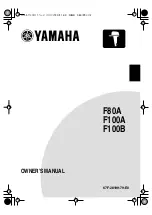M5251C3 Evaluation Board Users Guide, Rev. 0
Freescale Semiconductor
2-7
For the interactive mode, the user enters the command and the optional <addr>. If the address is not
specified, then the last address is used. The memory contents at the address are disassembled, and the user
prompted for the new assembly. If valid, the new assembly is placed into memory, and the address
incremented accordingly. If the assembly is not valid, then memory is not modified, and an error message
produced. In either case, memory is disassembled and the process repeats.
The user may press the <Enter> or <Return> key to accept the current memory contents and skip to the
next instruction, or a enter period to quit the interactive mode.
In the non-interactive mode, the user specifies the address and the assembly statement on the command
line. The statement is the assembled, and if valid, placed into memory, otherwise an error message is
produced.
Examples:
To place a NOP instruction at address 0x00010000, the command is:
asm 10000 nop
To interactively assembly memory at address 0x00400000, the command is:
asm 400000
2.4.2
BC (Block Compare)
Usage: BC addr1 addr2 length
The BC command compares two contiguous blocks of memory on a byte by byte basis. The first block
starts at address addr1 and the second starts at address addr2, both of length bytes.
If the blocks are not identical, the address of the first mismatch is displayed. The value for addresses addr1
and addr2 may be an absolute address specified as a hexadecimal value or a symbol name. The value for
length may be a symbol name or a number converted according to the user defined radix (hexadecimal by
default).
Example:
To verify that the data starting at 0x20000 and ending at 0x30000 is identical to the data starting at
0x80000, the command is:
bc 20000 80000 10000
2.4.3
BF (Block Fill)
Usage: BF <width> begin end data <inc>
The BF command fills a contiguous block of memory starting at address begin, stopping at address end,
with the value data. <Width> modifies the size of the data that is written. If no <width> is specified, the
default of word sized data is used.
The value for addresses begin and end may be an absolute address specified as a hexadecimal value, or a
symbol name. The value for data may be a symbol name, or a number converted according to the
user-defined radix, normally hexadecimal.
Summary of Contents for freescale M5251C3
Page 1: ...Document Number M5251C3UG Rev 0 05 2006 M5251C3 Evaluation Board Users Guide ...
Page 6: ...M5251C3 Evaluation Board Users Guide Rev 0 vi Freescale Semiconductor ...
Page 18: ...M5251C3 Evaluation Board Users Guide Rev 0 1 12 Freescale Semiconductor ...
Page 42: ...M5251C3 Evaluation Board Users Guide Rev 0 2 24 Freescale Semiconductor ...
Page 68: ...M5251C3 Evaluation Board Users Guide Rev 0 B 6 Freescale Semiconductor ...

















